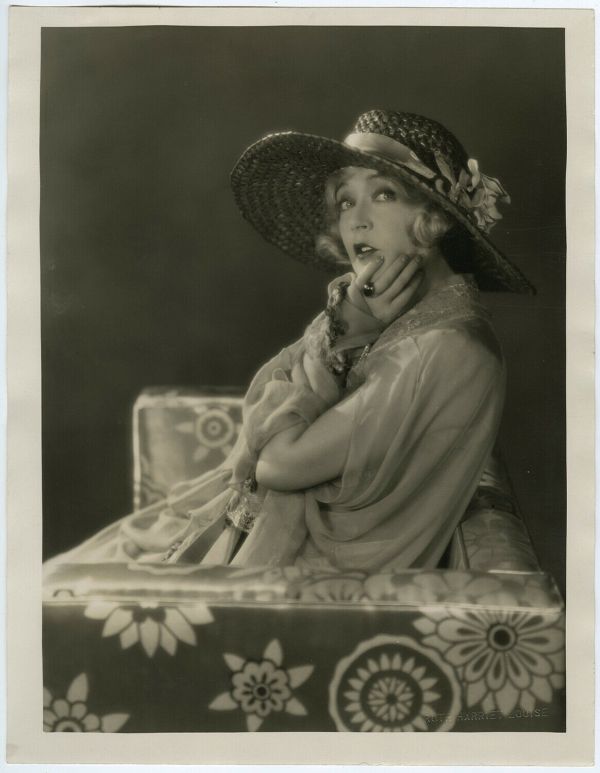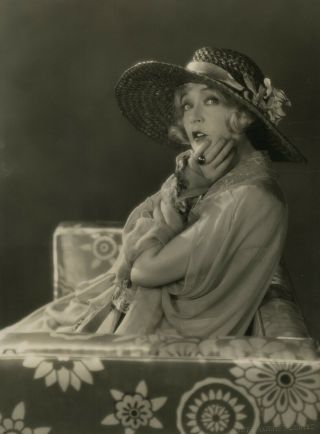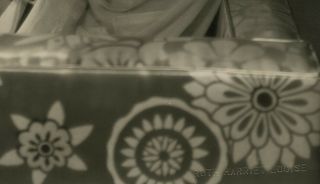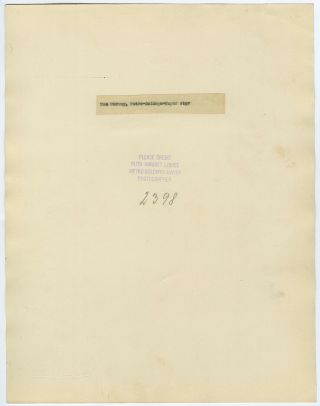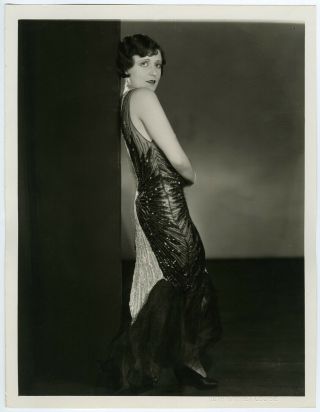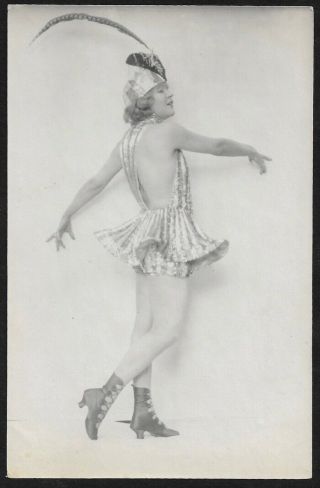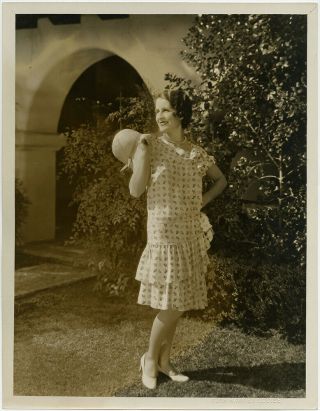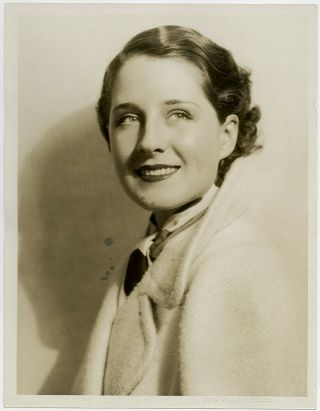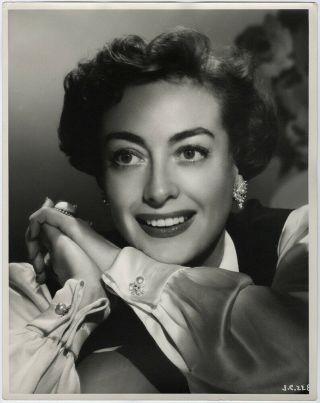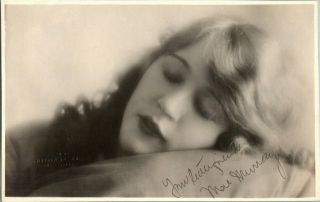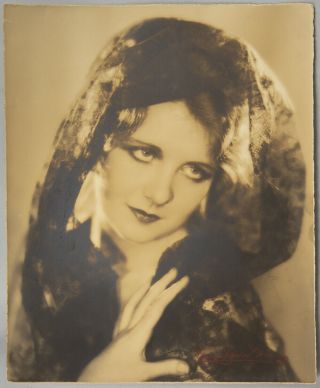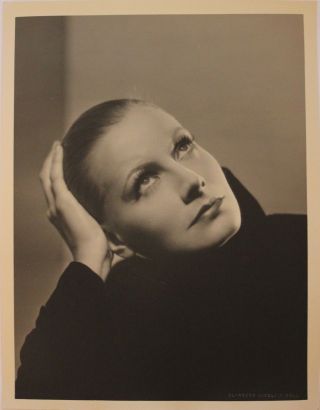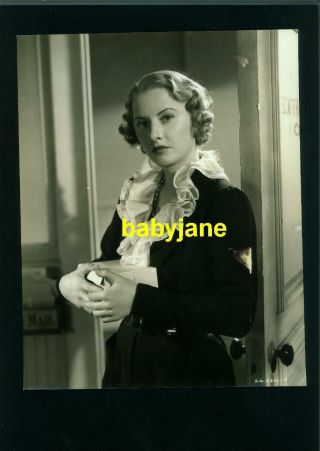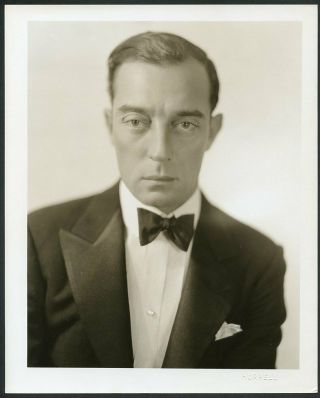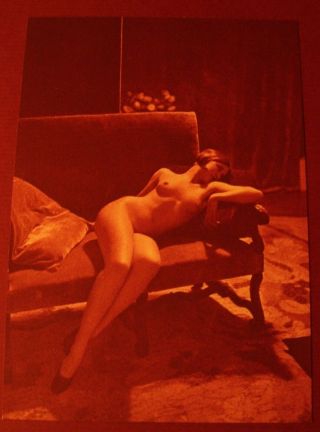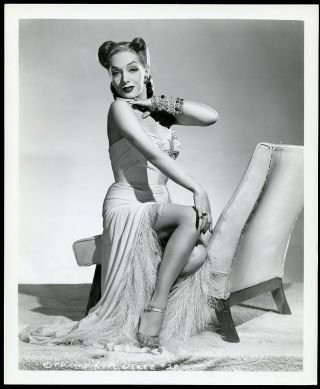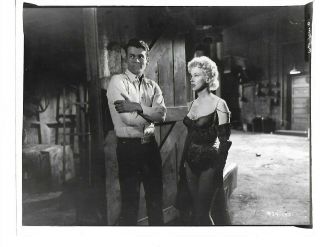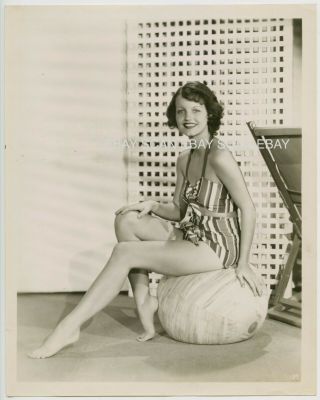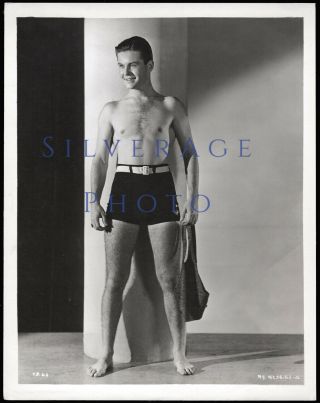Large 1920s Mae Murray Divine Glamour Photograph By Ruth Harriet Louise
Item History & Price
A Ziegfeld Follies girl and ballroom dancer, Murray was soon whisked off to Hollywood where producer Adolph Zukor tried to make her into a second Mary Pickford. Murray later signed with Metro Pictures where she made a handful of successful films with her then-husband, director Robert Z. Leonard. The couple split, but Murray would go on to her greatest success at the newly formed MGM. After nearly a year of fireworks and nervous breakdowns, the volatile combination of Murray, leading man John Gilbert and director Erich von Stroheim produced the classic "The Merry Widow" (1925). After three more MGM films, Murray ran out on her contract to marry specious 'Prince' David Mdivani. She made occasional stage appearances and then seemingly retired before resurfacing in New York in 1930, with a son, broke and husbandless.
Photograph measures 10.5" x 13.5" on a glossy double weight paper stock with the photographer's blind stamp in the bottom right corner, and a studio paper caption and photographer's ink stamp on verso.
Guaranteed to be 100% vintage and original from Grapefruit Moon Gallery.
More about Mae Murray:
Dubbed "The Girl with the Bee Stung Lips" and "The Gardenia of the Screen, " silent screen star Mae Murray was born in New York City as Marie Adrienne Koenig on May 10, 1885. The middle of three children born to French and German émigrés, she began studying dance at a young age.
Mae's professional career hit an early break when she partnered with ballroom extraordinaire Vernon Castle in the 1906 Broadway show "About Town." She continued in the chorus with such New York shows as "The Great Decide" (1906), "Fascinating Flora" (1907), "The Hoyden" (1907) and "The Merry-Go-Round" (1908). The lovely lady eventually joined the "Ziegfeld Follies" chorus line in 1908. After moving up in status with featured/co-star roles in the Broadway productions of "The Young Turk" (1910), "The Broadway Belles" (1910) and "The Little Highness" (1913) and "The Daisy" (1914), Mae moved up to become a Ziegfeld headliner in 1915. Mae played the top clubs in Paris and in America in an act that accentuated her dancing prowess. Other highly smooth dance partners would follow, including Clifton Webb, Rudolph Valentino and John Gilbert.
In 1916, the strikingly exotic beauty with the frizzy blonde hair moved to films a year later starring as Lady Joselyn alongside handsome Wallace Reid as Captain Ralph Percy in the To Have and to Hold (1916), produced by pioneer producer Jesse L. Lasky. The success of that film helped move her quickly up the ladder with Lasky starring her in such romantic comedies and dramas as the title role in Sweet Kitty Bellairs (1916), plus The Dream Girl (1916), The Plow Girl (1916), A Mormon Maid (1917) and The Primrose Ring (1917).
Mae became Universal Picture's new darling in the films Princess Virtue (1917), On Record (1917), The Bride's Awakening (1918), Her Body in Bond (1918), Modern Love (1918), Big Little Person (1919) and The Scarlet Shadow (1919). Many of her films, containing dance sequences designed especially for her, were written and produced by her third husband (of four), Robert Z. Leonard, whom she married in 1918 and divorced in 1925. Mae remained a top star, moving around for different studios playing opposite a number of handsome leading men, including The Gilded Lily (1921) with Lowell Sherman; Peacock Alley (1922) and Broadway Rose (1922) both with Monte Blue; Jazzmania (1923) and The French Doll (1923) both with Rod La Rocque; and, most notably, The Delicious Little Devil (1919) and Big Little Person (1919) both opposite Rudolph Valentino.
Brought over to MGM, Mae's most acclaimed film would be The Merry Widow (1925) opposite matinée idol John Gilbert and written and directed by Erich von Stroheim. She also starred in the romantic drama The Masked Bride (1925) and appeared in the title role in Valencia (1926); Altars of Desire (1927). Her last silent film was the MGM romantic drama Altars of Desire (1927) opposite Conway Tearle.
Mae's movie career faded with the advent of sound. Her first sound film, Peacock Alley (1930), received lackluster reviews and failed at the box office. As time had taken its leading lady toll on her (she was now past 40), her voice and mannerisms were not deemed suited to talkies. She might have remained on the MGM for a few more years; however, her fourth and last husband, Prince David Mdvani, who she allowed control over her business affairs, ill-advisedly had her leave the studio. Mae only made two more films. She was billed third, behind Lowell Sherman and Irene Dunne in the romantic dramedy Bachelor Apartment (1931) and a co-starring role opposite Sherman again in the crime caper High Stakes (1931). Divorcing Mdvani in 1934, Mae lost her son in a nasty custody battle.
The former actress grew more eccentric over the years and was eventually forced to declare bankruptcy, living in abject poverty for the better part of her later life. The 74-year-old lady managed to co-write her autobiography in 1959 entitled "The Self-Enchanted" and ended her days in the Motion Picture Country Home in Woodland Hills, CA. She died of a heart ailment on March 23, 1965. Although forgotten for the most part, in her heyday, Mae was a huge draw and above-the-title star, becoming one of the few Ziegfeld dancer attractions to hit big-screen stardom.
- IMDb Mini Biography By: Gary Brumburgh
More about Ruth Harriet Louise:
Motion picture production jobs both on and off the set have mostly been held by men throughout history, and those for still photography are no different. Early stills men were mostly cameramen who also acted as photographers of scene stills, like Alvin Wyckoff for Selig Studios. D. W. Griffith hired James Woodbury to assist and take stills for “Intolerance, ” and others started following suit. Studios created key books for each film, with photographs organized by scene number, and with each film assigned its own code. These images could be then be referenced and duplicated, to be sent out as publicity for the picture.
The studios soon realized that portraits of the stars could more easily sell films to consumers. These photographs were sent en masse to hundreds of magazines and newspapers, which required a never ending stream of material for publication. Portraits also were numbered in each studio’s own code system, and organized in key books as reference for approved shots of each star.
Most star portraits in the 1910s were taken by independent photographers like Albert Witzel, Hoover, Fred Hartsook, Melbourne Spurr, and the like. Mary Pickford hired her own photographer, K. O. Rahmn, and Mack Sennett hired the artistic James Abbe for some special shoots, along with such stills men as George Cannons and A. J. Kopec. Samuel Goldwyn hired Clarence Sinclair Bull in 1920, and Paramount hired Eugene Robert Richee in 1923. By the late 1920s, each studio possessed its own in-house photography studio and staff photographers. Ruth Harriet Louise was the only woman employed by any of the film studios during their glory days, and she acted independently, not just as a figurehead.
Born in New York on Jan. 13, 1903, Ruth Goldstein grew up as the daughter of Rabbi Jacob Goldstein and his wife, Klara, in New Jersey, along with her brother Mark. She dreamed of becoming a painter, but after a portrait session with the renowned New York photographer Nickolas Muray, she enrolled in a photographic school and apprenticed. In 1922 she opened her own studio in Trenton, N.J., advertising in “The Banner, ” “Won’t you visit my studio, and let me perpetuate your personality, ” per Robert Dance and Bruce Robertson’s “Ruth Harriet Louise and Hollywood Glamour Photography.” She quickly gained clientele, and by 1923 changed her name professionally to Ruth Harriet Louise.
Her brother Mark had followed their cousin Carmel Myers to Hollywood in 1922, and by 1925 he was writing and directing films. He had also professionally changed his name to Mark Sandrich, and would later direct Fred Astaire and Ginger Rogers in “Top Hat” and “Carefree” among others. Louise traveled across country later that year to join him in Los Angeles. She opened a little studio at Hollywood and Vine, and by September her first photograph appeared in “Photoplay” magazine, that of Vilma Banky in “Dark Angel” for Samuel Goldwyn.
Myers also assisted Louise; she showed studio chief Louis B. Mayer some of her portraits, and not longer after, Louise was hired as MGM’s in-house studio photographer. She was all of 22. On her $50-a-week salary, she would schedule five to six sessions a day, six days a week, crafting an elegant and glamorous image to sell to movie fans. To help loosen up the stars and help them find the mood she wanted, Louise played records. Her aim was to capture their personality, bottle it, and sell it to an eager public. Louise employed mood lighting, a soft, almost pictorialist style, and glamour in her shooting, and in her words, “…creating a personality.” Using 8 x 10 negatives, she produced both 11 x 14 and 8 x 10 prints after careful retouching and reframing.
Virtually all of the MGM stars liked her and enjoyed her company. She loved to sit around and talk after shooting, as well as joking and laughing while working. Louise seemed to enjoy working with almost everyone. She called Lillian Gish one of her favorite sitters in “Everybody’s Weekly, ” on Sept. 8, 1928. She mentioned that she found Greta Garbo “…one of the saddest girls I’ve ever seen.” Louise described Lon Chaney as incredibly expressive and astute as to the moods she suggested. She found him an enigma however, described John Gilbert as a boy, William Haines as a more sophisticated boy, and Lillian Gish as a strong, in control person.
She played music to set the mood for what she wanted. Louise stated that Haines looked best when cheery songs like “Hallelujah” and “Girl Friend” played.
On Aug. 27, 1927, she married Universal writer Leigh Jacobson. The youngest writer on staff, he wrote westerns and serials and supervised their editing. Jacobson wanted to be a director so much he quit in December 1927 when the studio refused to allow him to switch. Making a two-reel film for $1, 000, he changed his name to Leigh Jason, and then attempted to sell it by states’ rights. Studio Chief Carl Laemmle saw it and asked to see the director. Laemmle rehired him as a director, but didn’t use the film.
Things began changing in Hollywood in the late 1920s. Unions came in to give workers more rights, better working conditions, and better wages. Stills photographers unionized as Local 659 in August 1928, but Louise never joined. The studio was growing astronomically from a family-like atmosphere to a huge conglomerate, and personal relationships altered and changed. There was less time to gossip and relax. Norma Shearer scheduled a sitting with George Hurrell to make more sexy stills, and Louise’s power diminished. The stock market crash also created a more tense atmosphere.
“Variety” reported on Dec. 11, 1929, that Louise had resigned from MGM, to be replaced by George Hurrell. The article stated she would start her own studio. As is the history in Hollywood, most resignations are often firings. Louise would take portraits of Anna Sten for Goldwyn and work out of her home for awhile, but the work soon petered out. She gave birth in 1931 to her first child, Leigh Jr., and daughter Brenda was born a few years later. In 1938, Leigh Jr. died of leukemia.
On Oct. 12, 1940, Louise died at the age of 37, from complications of childbirth, and the baby also died. Both The Los Angeles Times and Variety obituaries called her Mrs. Ruth Jason and listed her residence as 311 S. Beverly Glen Blvd. “Variety” does note that her professional name was Ruth Harriet Louise, under which she was “…one of the top portrait photographers…” in late 1920s Hollywood.
In 1942, her brother Mark donated two bungalows in her memory at the Motion Picture Country House. Jason would continue to direct, as well as invent. He applied for patents, particularly for a smokeless ashtray for theaters, airplanes, and cars, which GM would buy the rights for. In the early 1950s, he married Mark Sandrich’s niece Jerry Lieberman.
Louise’s work was little recognized for decades, until Dance and Robertson helped resurrect her memory with their excellent biography and exhibits of her work around the country. There are several important women stills photographers in Hollywood, and many famous portrait artists like Annie Leibowitz and Linda McCartney, who owe parts of their success to Ruth Harriet Louise and her blazing trail at MGM.
Biography By: Mary Mallory: Hollywood Heights – Ruth Harriet Louise



